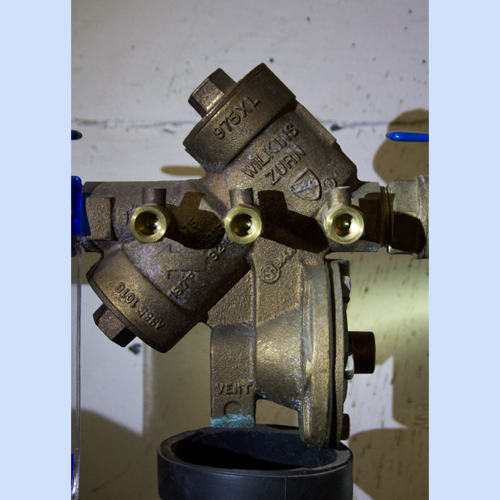
Backflow prevention devices are essential to prevent the risk of contamination of drinking water. However, their use causes certain non negligeable disadvantages that must be considered when selecting and installing them. It is the responsibility of the designer (ie. the engineer) to inform the building owner of the possible consequences of adding one or more devices to his drinking water network. Most often, pressure losses will be observed in the water distribution network, which may cause water damage or require more frequent preventive maintenance.
Nevertheless, any building owner of industrial, businesses and institutional type is subject to regulations aimed at maintaining the drinking character of water. In Quebec, although the installation of backflow prevention devices on drinking water pipes has always been required by the Construction Code, its application was reinforced in the early 2000s. Since 2004, inspectors from the Régie du bâtiment du Québec (RBQ) are making considerable efforts to make building owners aware of the compliance with standards and laws. The National Plumbing Code (NOC) 2010, currently in force refers to CSA B64.10 for the selection and installation of backflow prevention devices. The Safety Code, which covers existing buildings, requires owners not only to install backflow prevention devices, but also to carry out their annual maintenance.
To ensure the proper functioning of the drinking water network, the following are the main elements to be considered when designing or upgrading to standards.
By design and operation, all backflow prevention devices have a resistance to water flow which results in a loss of pressure. If the required device protects against a high risk, this pressure loss can reach12 psi or 0.8 bar. In general, this pressure loss is compensated by a high pressure coming from the water system. However, the consequences can be critical in the presence of a building over three floors, especially if equipment is installed on the top floor and requires a minimum of 35 psi to function properly. In this type of situation, avoid replacing the device with a model offering less resistance. The installation will then become non-compliant and will not offer optimal protection against contamination. Thus, despite additional costs, the best solution is to add booster pumps, to maintain the required pressure in the water network.
Although manufacturers of backflow prevention devices attest that their equipment offers to high temperatures, the fact remains that they are made with plastic and rubber components. These materials are sensitive to heat, even if manufacturers guarantee a resistance to 175 C. The components degrade faster than in an environment where the water is cold or temperate. It is recommended to reconfigure the supply lines to protect the hot water upstream of the reservoir and to dedicate this hot water to high-risk applications.
Some backflow prevention devices require a permanent indirect connection to a drain. However, it happens that no drain is accessible nearby. In this case, rather than installing a device that does not require access to a drain, which would make the installation non-compliant, it is recommended that the device be relocated. If this solution is not impossible, then consider cutting the concrete slab to set up a floor drain. This solution is more expensive, but it ensures compliance of the installation.
The first consequence following the installation of a backflow prevention device is the creation of a closed network, in which overpressure can be a problem. Indeed, the primary purpose of a backflow prevention device is to allow the passage of water to its point of consumption, but not in the opposite direction, which is called a backflow. With the network now closed, the pipe becomes sensitive to an increase in pressure, especially if the objective is to supply a hot water tank. To counter this natural physical phenomenon, the designer must provide for the installation of appropriate equipment to release any excess pressure in the pipe. Thus, this would prevent damage to the components of the water network.
While provincial and municipal inspectors are active in encouraging homeowners to bring their drinking water systems up to standard, it is clear that, despite their goodwill, they act without knowing all the consequences of their decisions. Very often, these installations have the effect of causing major dissatisfaction which ends in dismantling and disappointment with a device whose role is to protect our most precious resource, drinking water. The designer has the duty to clearly define the conditions of the installation, to measure the parameters that will be altered and to propose a solution that will withstand the fluctuations present in the drinking water distribution network.
We use cookies to understand how you use our site and to improve your experience. This includes personalizing content and advertising. By continuing to use our site, you accept our use of cookies, terms and conditions, privacy policy. Confused? Send us an e-mail.
I acceptWe use cookies
Respecting your privacy matters to us. We use cookies to personalize our content and facilitate your digital experience. Some cookies may be collected with your consent.
Essential
Essential cookies help make a website usable by enabling basic functions such as page navigation and access to secure areas of the website. The website cannot function properly without these cookies.
Performance
These cookies enable us to analyze navigation on our sites and improve their operation.
Customization
Preference cookies enable a website to remember information that modifies the behavior or appearance of the site, such as your preferred language or the region you are in.
Targeted advertising
These cookies help us limit the number of times you see an advertisement, personalize our offers and services according to your centers of interest, measure the effectiveness of an advertising campaign, and so on. They may be shared with our partners.
We use cookies
Respecting your privacy matters to us. We use cookies to personalize our content and facilitate your digital experience. Some cookies may be collected with your consent.